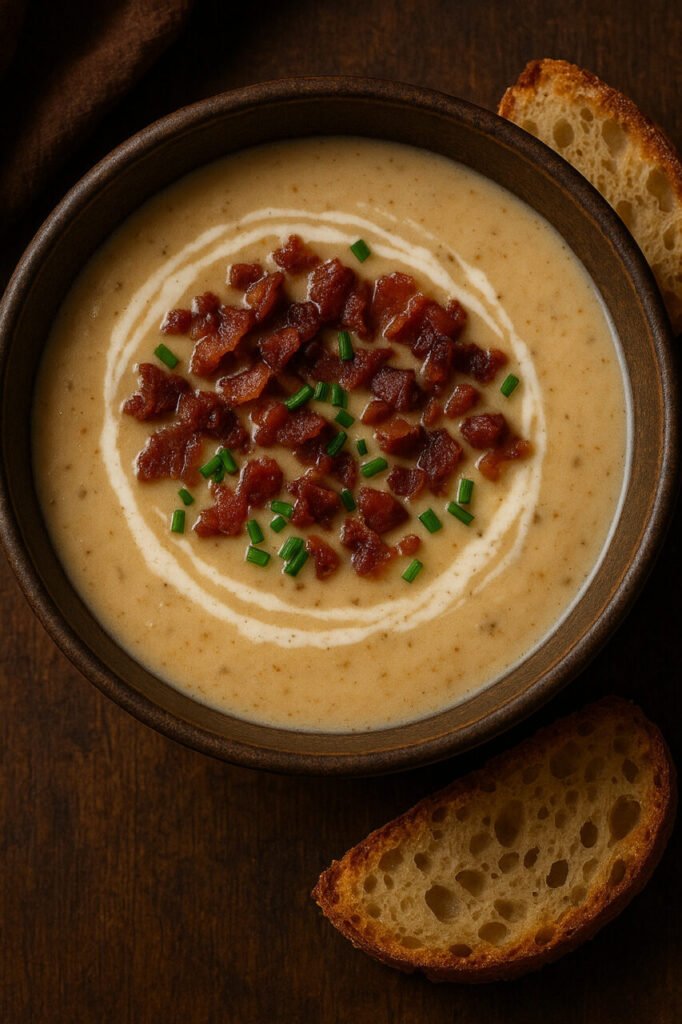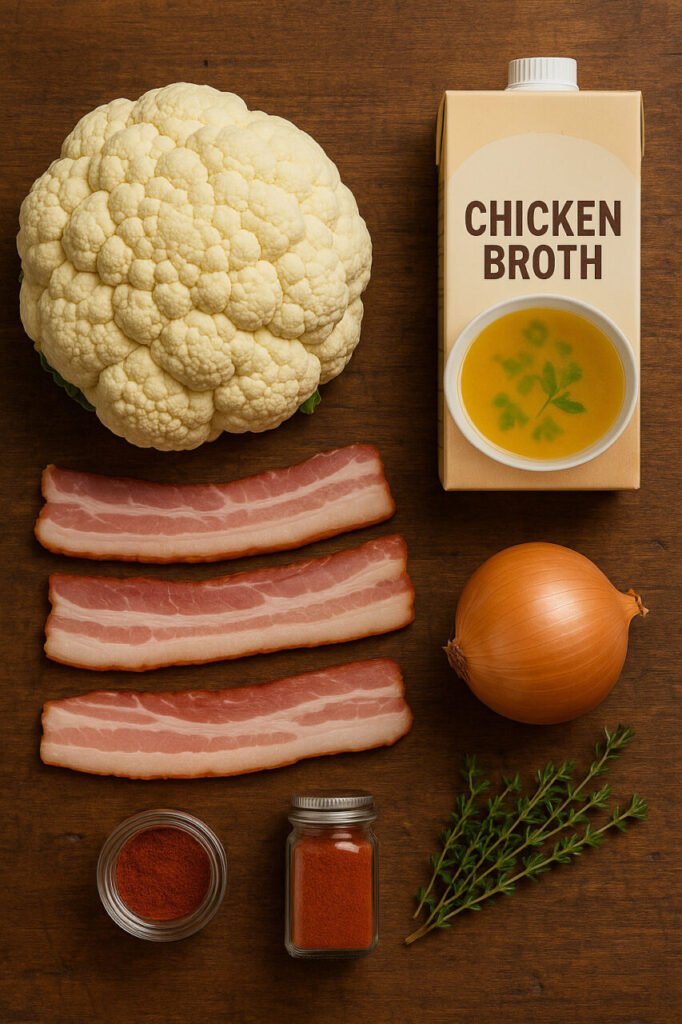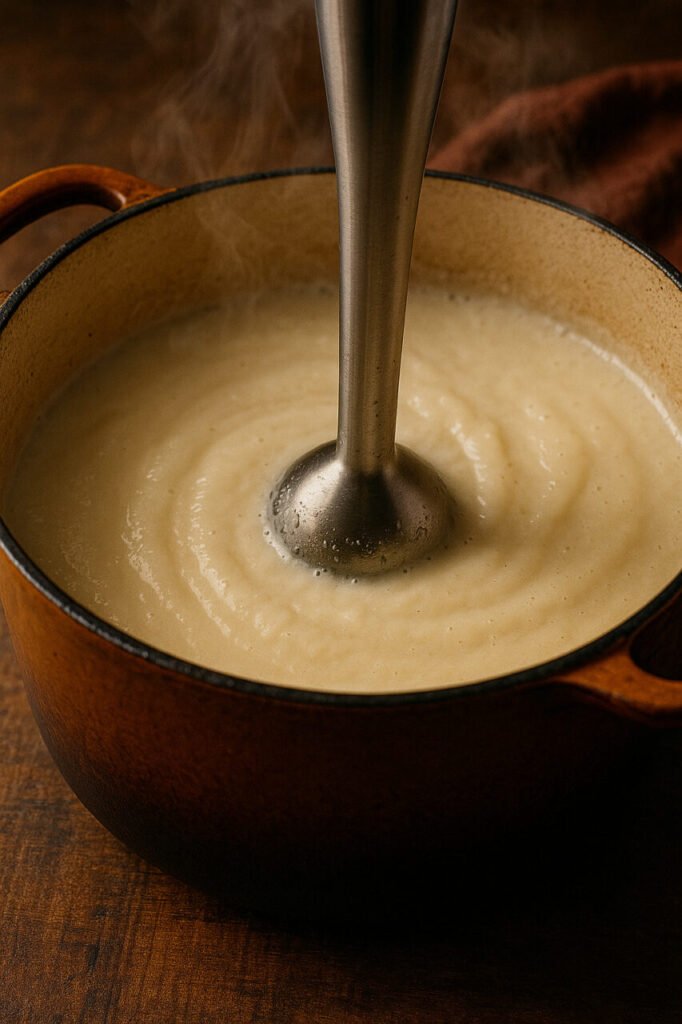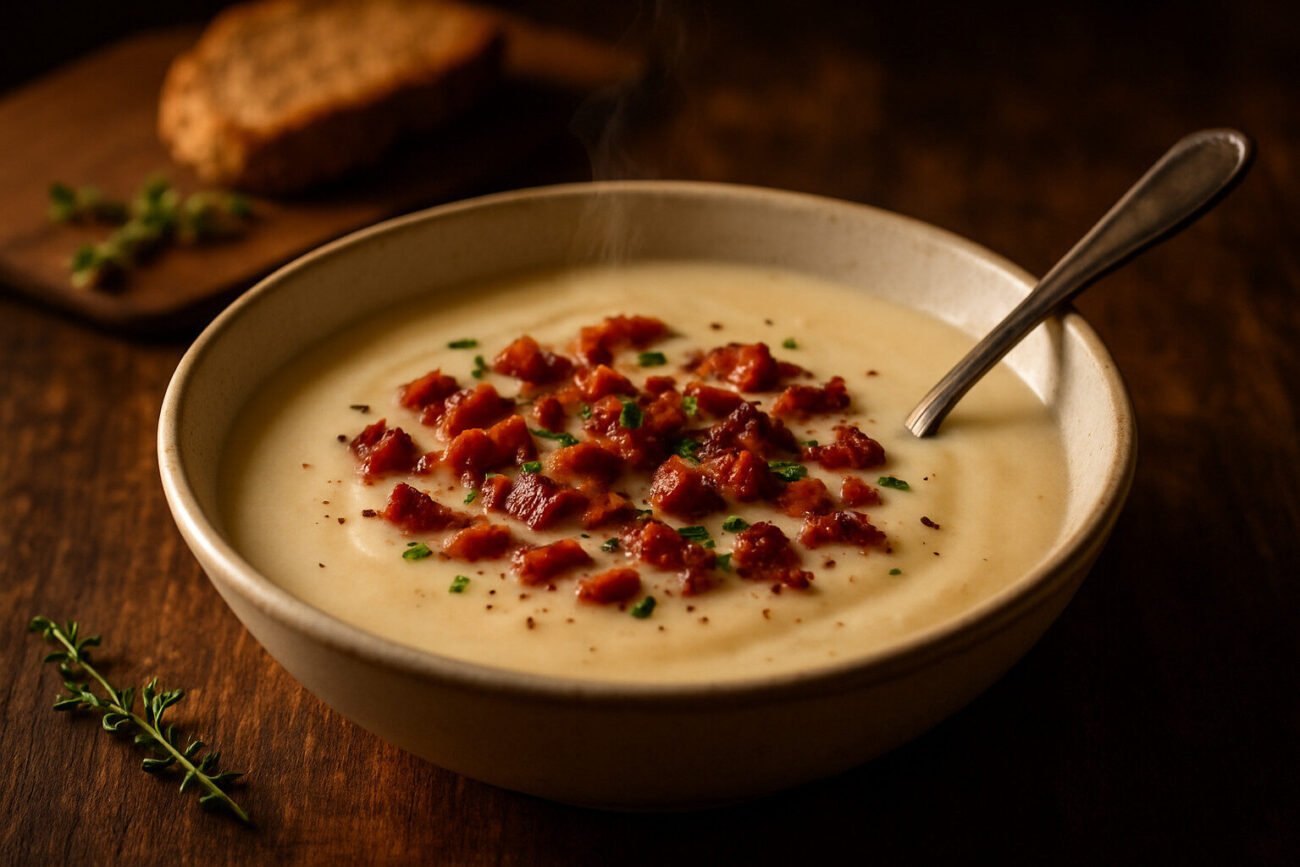This isn’t just another cauliflower soup recipe. This is the one I make weekly during recipe testing season, the one my family actually requests, and the one that consistently delivers restaurant-quality depth without the carb-heavy consequences. After developing hundreds of soup recipes, I’ve found this particular combination of technique and ingredients creates something truly special—a creamy, luxurious texture and smoky flavor profile that makes you forget you’re eating a vegetable-centric, keto-friendly dish. I’m sharing my professional approach to building layers of flavor, because that’s what separates a good soup from a great one.

Why This Bacon Cauliflower Soup Recipe is a Game-Changer
Most keto soups rely too heavily on fat for satisfaction, missing the mark on complex flavor. Or they taste like… well, boiled cauliflower. This recipe is different because it applies fundamental culinary techniques—like properly rendering fat and building a flavor base—to a simple set of ingredients. The result? A soup that feels indulgent but is nutritionally smart. It’s a workhorse recipe for busy weeknights but is elegant enough for a dinner party starter. Honestly, it’s the soup that converts cauliflower skeptics.
The Perfect Balance of Richness and Nutrition
Let’s talk macros for a moment, because in the keto world, that matters. This <b>Bacon Cauliflower Soup</b> achieves a remarkable balance: it’s high in healthy fats from the bacon and cream, moderate in protein, and extremely low in net carbohydrates. But beyond the numbers, it’s satiating. The fat content provides a sustained energy release, unlike a carb-heavy soup that leads to a crash. From a culinary perspective, the fat is also a carrier for flavor compounds, meaning every spoonful tastes more profound. It’s not just “healthy”; it’s strategically formulated to be both nutritionally sound and deeply satisfying on a sensory level. You can check the official USDA FoodData Central for detailed nutritional profiles of the core ingredients.
Unlocking Deep, Smoky Flavor Without the Carbs
The smokiness here isn’t one-dimensional. It’s a trilogy. First, you have the rendered bacon fat, which forms the foundation. Then, a touch of smoked paprika—this is my professional secret weapon. It reinforces the bacon’s smokiness without making the soup taste like bacon alone. Finally, and perhaps most importantly, the Maillard reaction from properly sautéing the cauliflower in the bacon fat creates those beautiful, complex, toasty notes. This layering is what prevents the flavor from falling flat. You’re not just adding smoky ingredients; you’re building a smoky environment for the soup to develop in. For a deep dive on the science of these reactions, Serious Eats has fantastic resources.
My Go-To Recipe for Effortless Meal Prep
I test recipes for a living, so my tolerance for fussy, complicated dishes is low. This <b>Bacon Cauliflower Soup</b> is a meal prep champion for several practical reasons. The flavor actually improves after a day or two, as the ingredients have more time to meld. It reheats beautifully without breaking or graining. And it’s versatile—it can be a light lunch with a salad or a hearty dinner with a protein add-in. I often double the batch and freeze it in portions. It’s one of those rare recipes that saves you from the “what’s for dinner” panic while ensuring you’re eating something genuinely good for you.
Gathering Your Ingredients and Tools
Using the right ingredients and tools isn’t just pedantic chef talk; it’s the difference between a fine soup and a fantastic one. The quality of your bacon will directly influence the depth of your base, and the type of blender you use will determine the final texture. I’m specific about these recommendations because I’ve seen the results vary dramatically in my own kitchen.
The Complete Ingredient List for Maximum Flavor
- 1 large head of cauliflower (about 2 pounds), cored and cut into 1-inch florets
- 6 ounces thick-cut, sugar-free bacon, diced
- 1 medium yellow onion, diced
- 2 cloves garlic, minced
- 4 cups low-sodium chicken broth (or bone broth for extra protein)
- 1 cup heavy cream
- 1 teaspoon smoked paprika
- 1/2 teaspoon onion powder
- 1/4 teaspoon freshly grated nutmeg (trust me, it makes a difference)
- Sea salt and freshly cracked black pepper to taste
- For garnish: Extra crispy bacon, shredded cheddar cheese, sliced chives, or a drizzle of sour cream.
Professional Note: Thick-cut bacon is non-negotiable here. It renders more fat for cooking your aromatics and provides a better texture when crisped. Always check your bacon label for hidden sugars like dextrose or maple syrup to keep it truly keto.
Essential Kitchen Equipment for a Smooth Process
- A heavy-bottomed Dutch oven or large soup pot. This ensures even heat distribution, preventing the fond (those browned bits at the bottom) from burning.
- A sharp chef’s knife and cutting board. Uniformly diced onions and cauliflower ensure even cooking.
- An immersion blender. This is my tool of choice for this recipe. It allows you to blend the soup directly in the pot to your desired consistency—perfectly smooth or rustic with some chunks.
- A high-speed blender is an alternative, but you must be cautious. Blend in batches and vent the lid to prevent a steam explosion that can burn you and make a huge mess. I’ve done it. It’s not fun.
- Ladle, measuring cups, and basic utensils.

Crafting Your Soup: A Step-by-Step Method
This method is about patience and building flavor in stages. Rushing through the initial steps is the most common mistake I see. Don’t just cook the bacon; render it perfectly. Don’t just soften the onions; sweat them until they’re sweet and translucent. These steps form the soul of the soup.
Step One: Rendering the Bacon to Perfection
Place the diced bacon in a cold Dutch oven. This is key. Starting in a cold pot allows the fat to render out slowly and evenly as the pan heats up. Turn the heat to medium and cook, stirring occasionally, until the bacon is crispy and the fat has fully melted. This should take 8-10 minutes. Use a slotted spoon to remove the bacon bits, leaving the beautiful rendered fat behind. Reserve the crispy bacon for garnish. This fat is now your cooking oil, infused with incredible smoky, porky flavor.
Step Two: Building a Flavorful Foundation
Add the diced onion to the hot bacon fat. You should hear a gentle sizzle. Cook, stirring occasionally, until the onions are soft and translucent, about 5-7 minutes. Add the minced garlic and cook for just 60 seconds more—until fragrant. Don’t let the garlic brown, or it will turn bitter. Now, add the cauliflower florets, smoked paprika, onion powder, and a pinch of salt and pepper. Stir to coat every piece of cauliflower in the flavorful fat. Cook for another 5 minutes, allowing the cauliflower to soak up the flavors and just begin to soften on the edges.
Step Three: Simmering to Creamy Perfection
Pour in the chicken broth, scraping the bottom of the pot with your spoon to release all those browned bits (the fond). This is pure flavor. Bring the soup to a boil, then immediately reduce the heat to a gentle simmer. Cover and let it cook for 20-25 minutes, or until the cauliflower is completely tender and easily pierced with a fork. The low, slow simmer is what coaxes the sweetness from the cauliflower and melds all the flavors together.
Step Four: The Final Touch – Blending and Serving
Turn off the heat. This is where you choose your texture. Using an immersion blender, carefully blend the soup directly in the pot until it reaches your preferred consistency—I like it mostly smooth but with a bit of body. Stir in the heavy cream and the nutmeg. Warm it through gently over low heat for 2-3 minutes; do not boil after adding the cream, as it can sometimes separate. Taste and adjust seasoning with more salt and pepper if needed.

Ladle the soup into bowls and garnish generously with the reserved crispy bacon, a sprinkle of cheddar cheese, and a flourish of fresh chives. Serve immediately.
Frequently Asked Questions
Can I make this Bacon Cauliflower Soup dairy-free?
Absolutely. The cream adds richness, but you can achieve a similar effect with full-fat canned coconut milk. The flavor will have a slight coconut undertone, but it pairs surprisingly well with the smokiness. For a nuttier flavor, you could also use unsweetened almond milk, but I’d add a tablespoon of nutritional yeast or a bit of ghee to compensate for the lost richness.
How can I store and reheat leftovers properly?
Store cooled soup in an airtight container in the refrigerator for up to 4 days. To reheat, do so gently on the stovetop over medium-low heat, stirring occasionally. If it has thickened too much, whisk in a splash of broth or water to loosen it. You can also freeze this soup for up to 3 months. Thaw overnight in the fridge before reheating. The National Center for Home Food Preservation offers excellent guidelines for safe freezing practices.
What can I use if I don’t have an immersion blender?
A standard countertop blender works, but requires caution. Let the soup cool slightly, then blend in small batches. Never fill the blender more than halfway, and hold the lid down firmly with a kitchen towel to prevent a steam explosion. You can also use a food processor, though the texture might be slightly less smooth. For a completely rustic, chunky soup, you could even use a potato masher.
Is this soup suitable for a strict keto diet?
Yes, when made as written with sugar-free bacon, it is absolutely keto-friendly. A typical serving contains approximately 5-7 grams of net carbs, primarily from the cauliflower and onion. The vast majority of its calories come from fat, making it an ideal meal for maintaining ketosis. As always, if you’re tracking strictly, I recommend plugging the specific brands you use into a nutrition calculator.
Can I add other vegetables to this recipe?
You can, but it will change the carb profile. A handful of spinach stirred in at the end would wilt nicely. Some readers have told me they’ve added half a cup of chopped radishes, which maintain a low-carb count and add a subtle peppery note. I’d avoid starchy vegetables like potatoes or carrots if you want to keep it keto.
How can I make this soup spicier?
I love adding a kick! The easiest way is to include a pinch of cayenne pepper or red pepper flakes when you add the other spices. Alternatively, you could sauté a diced jalapeño (seeds removed for less heat) with the onions at the beginning. A dash of hot sauce at the end is another quick fix.



